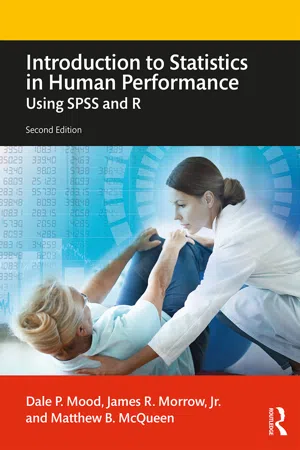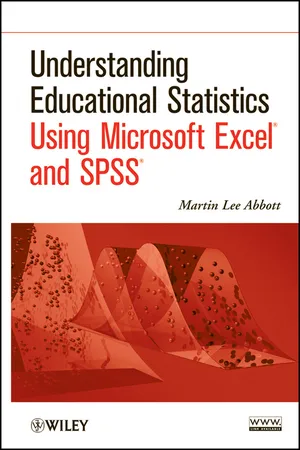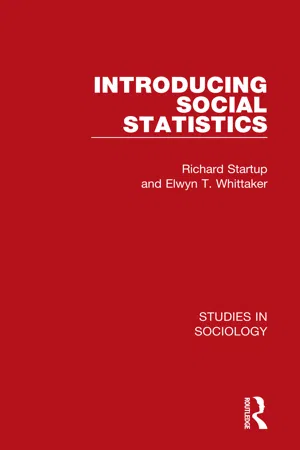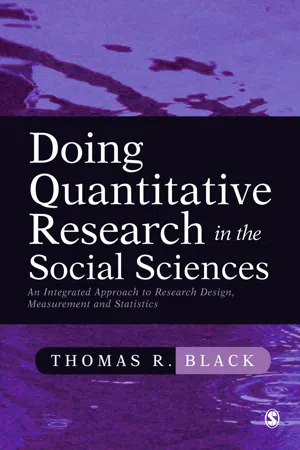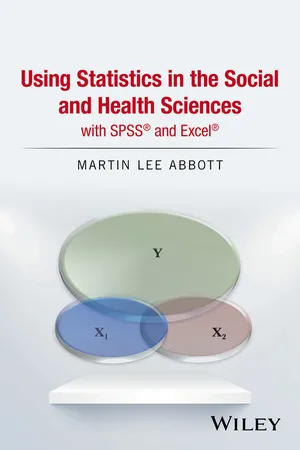Technology & Engineering
Two Sample Test
A two-sample test is a statistical method used to compare the means of two independent groups to determine if they are significantly different from each other. It is commonly used in research and engineering to assess the impact of a treatment or intervention, or to compare the performance of two different technologies or processes. The test helps to determine if any observed differences are statistically significant.
Written by Perlego with AI-assistance
Related key terms
11 Key excerpts on "Two Sample Test"
- eBook - ePub
Medical Statistics
A Guide to SPSS, Data Analysis and Critical Appraisal
- Belinda Barton, Jennifer Peat(Authors)
- 2014(Publication Date)
- BMJ Books(Publisher)
Chapter 3 Comparing two independent samplesDo not put faith in what statistics say until you have carefully considered what they do not say.WILLIAM W. WATTObjectives
The objectives of this chapter are to explain how to:- conduct an independent two-sample, parametric or non-parametric test
- assess for homogeneity of variances
- calculate and interpret effect sizes and 95% confidence intervals
- report the results in a table or a graph
- understand sample size requirements
- critically appraise the analysis of data from two independent groups in the literature
3.1 Comparing the means of two independent samples
A two-sample t-test is a parametric test used to estimate whether the mean value of a normally distributed outcome variable is significantly different between two groups of participants. This test is also known as a Student's t-test or an independent samples t-test. Two-sample t-tests are classically used when the outcome is a continuous variable and when the explanatory variable is binary. For example, this test would be used to assess whether mean height is significantly different between a group of males and a group of females.A two-sample t-test is used to assess whether two mean values are similar enough to have come from the same population or whether their difference is large enough for the two groups to have come from different populations. Rejecting the null hypothesis of a two-sample t - eBook - ePub
Introduction to Statistics in Human Performance
Using SPSS and R
- Dale Mood, James Morrow, Jr., Matthew McQueen(Authors)
- 2019(Publication Date)
- Routledge(Publisher)
7Two-Sample t-testINTRODUCTION
The one-sample case we examined at the end of Chapter 6 contains many of the important concepts of inferential statistics, but it has rather limited application in human performance research and in science in general. As we saw, the primary use of the one-sample case is to compare the mean of a sample () to a hypothesized mean of a population (μ). We learned that we can compare the two means and either accept the hypothesis that they are not different, except for sampling error (this is called the null hypothesis and symbolized as H0 ), or reject this hypothesis. We also saw that we can even attach various levels of confidence to our decision.X ¯We learned two ways to reach our decision. First, we learned how to construct a confidence interval around the sample mean and then to check to see whether the hypothesized population mean is located within this interval. If it is, we decide the null hypothesis is true and conclude that the difference between the two means is simply the result of sampling error. If the hypothesized population mean is not located in the interval, we reject the null hypothesis (that the means are not different) and accept the alternative hypothesis (symbolized as H1 ) that they are, in fact, different. Recall that the width of the confidence interval is a function of the level of confidence that is desired, the size of the sample, and the variability of the values in the population (represented by Σ).The second way to reach the same conclusion regarding the equality of the means, called hypothesis testing, is to determine where the sample mean is located on a hypothetical sampling distribution. This sampling distribution would, theoretically, be constructed by taking many, many different samples of the same size (N) from the population for which we know µ and σ, calculating the mean of each sample, and plotting them in a frequency distribution. The result would be a normal curve with a mean of µ and a standard deviation (here called the standard error of the mean,) equal toσX ¯. It is important to understand that the standard error of the mean is actually the standard deviation of the sampling distribution of the means that were calculated across many, many samples and then plotted. Although we never actually construct this sampling distribution, we do use our knowledge of the normal curve and the value ofσNto locate where our sample mean would reside in the hypothetical sampling distribution. We can create a 95% confidence interval by multiplying the value ofσX ¯σX ¯ - Martin Lee Abbott(Author)
- 2014(Publication Date)
- Wiley(Publisher)
T test is designed to do just that. This statistical procedure assesses whether two samples, chosen independently, are likely to be similar or sufficiently different from one another that we would conclude that they do not even belong to the same population.RESEARCH DESIGN
As we encounter new statistical procedures, I want to draw us back to our examination of research design. It is important to understand how a statistical procedure should be used rather than simply how to calculate it.If you recall, we distinguished experiment from post facto designs in Chapter 9. One of the key differences was whether the researcher manipulated the independent variable (experiment) or simply measured what data already exists (post facto ). The independent T test can be used with either design.Experimental Designs
Figure 11.1 shows the diagram for an experimental design in which there are two groups: experimental group and control group. As you can see, the treatment variable is manipulated by assigning one group (experimental) one level of a treatment and the other group (control) a different level (or no treatment at all). The dependent (outcome) variable is tested after the independent variable has been changed to see if there is a difference between the outcome measures of the two groups. If there is a difference, the researcher attributes the change to the presence or action of the independent variable (i.e., makes a causal attribution).FIGURE 11.1The research design with two groups.The researcher may only make causal attributions if there is randomization in which subjects are chosen and assigned to groups randomly. If randomization is present, then the assumption is that both groups (experimental and control) are equal at the outset. Then, if they are different on the dependent variable measure after the experiment is over, the differences must be because of the treatment that was introduced to change the experimental group and not the control group.- eBook - ePub
- Richard Startup, Elwyn T. Whittaker(Authors)
- 2021(Publication Date)
- Routledge(Publisher)
Chapter 7 Statistical Inference with Two Samples In the two previous chapters, we considered statistical problems involving single samples, but it is perhaps even more common in the social field to encounter situations where we need to make comparisons between two or more samples. This is often done in order to establish whether statistical relationships exist between attributes and/or variables. For instance, we might seek to discover whether children from single-sex schools differ on average in their performance in attainment tests from children in coeducational schools; or, we might wish to know whether paroled prisoners have a lower rate of reconviction than comparable unparoled groups. In this chapter we deal with two sample problems, leaving for consideration in Chapters 8 and 9 procedures which may be used with larger numbers of samples. When we have two samples, a basic statistical question is whether or not they might have been drawn from the same population or two identically distributed populations. However, the precise problem at issue varies depending upon the research design and the type of data, so we shall consider in turn in this chapter several of the more commonly encountered situations. We often ask, for instance, whether two independent random samples may have been derived from populations which differ in their average values. When the data are intervally scaled, we need to test whether there is a difference in the arithmetic means of the two populations. On the other hand, where we have nominal scaling, we would compare two samples in respect of the proportion of cases falling into a particular category and determine whether there was evidence of a difference of proportions in the underlying populations. There is, thirdly, a need for procedures directly comparable to tests involving differences of means and proportions which can be used with ordinal scaling - eBook - ePub
Doing Quantitative Research in the Social Sciences
An Integrated Approach to Research Design, Measurement and Statistics
- Thomas R Black(Author)
- 1999(Publication Date)
- SAGE Publications Ltd(Publisher)
Thus for the same difference in the two means, the potential power of the test will decline slightly if one has to compensate by modifying the test. Ultimately we will consider four versions of the t -test in this chapter, and others under nonparametric tests for comparing two groups in Chapters 19 and 20. In this chapter, you will be able to set up a simulation to explore the relationship among these assumptions and compare outcomes for different situations. You will also have at the end a worksheet into which you can enter raw data and generate the results for any one of the four tests, including an assessment of the power of each. From One Group to Two Having established a way of determining the likelihood of a sample belonging to a known population rather than a separate unknown one, it would seem that this could be extended to comparing two samples. There are definite similarities and the issue is much the same: if we have two samples, do they belong to one population or do they belong to two separate ones for the trait in question? For example, two random samples of employees are selected, one provided with a programme of motivation counselling to improve self-image and therefore productivity, and a second control group. Both groups respond to a written instrument to measure self-image both before and after the treatment period. At the end of the study, do both groups belong to the same population for the characteristic of interest, self-image, based on gain scores on the instrument? Assuming all extraneous variables were controlled, did the counselling have any effect and make them different? When testing the question of whether a sample belongs to a known population, the sample mean is compared to a distribution of possible sample means to see if it is within an acceptable range, often the 95% range of, the standard error of the mean (SEM) - David Heath(Author)
- 1995(Publication Date)
- CRC Press(Publisher)
9 Tests Using Two Independent Samples: Are the Two Populations Different?We now move on to situations in which we are taking two samples, one from each of two populations. These situations will arise in simple experiments involving just two treatments which could be a test of the effect of two temperatures on enzyme activity, two fertilizer levels on plant growth, or two pollution concentrations on animal survival. Two-sample tests will also be needed in ecological studies. We might wish to compare the frequencies of males and females caught using two different methods, the numbers of a given species in two different habitats or the time spent by pollinators foraging at two different times of day. If the samples have been chosen at random as described in Chapter 4 , then they will be independent samples. The meaning of this term will be examined more fully in the next chapter. In all these cases we would want to know whether the two populations from which the samples were taken were different. The basic problem is, of course, that even if the two populations are the same, the two samples are likely to be different because of sampling variation. As a consequence, the fact that the two samples are different does not necessarily mean that the two populations are different.As you can see from these examples, any type of variable can be involved and we shall also have to be clear about the sort of differences we are interested in. A typical question would be whether the two populations differ in their location (e.g. in their median or mean), but we might also want to know whether two populations differ in their variability. Different variables and different questions will require different statistical tests but the underlying principle is always the same.All the tests start with a null hypothesis which is that the two samples are drawn from two populations which are the same, which implies that the factor under investigation has no effect on the variable. Any differences between the samples are then merely due to sampling variation, that is, the chance events which occur during sampling. The alternative hypothesis will be that the two samples are drawn from different populations and this implies that the factor under investigation does have an effect on the variable. Our decision to reject the null hypothesis will be taken when the difference between the samples is judged to be too large to be likely to be due to sampling variation.- Martin Lee Abbott(Author)
- 2016(Publication Date)
- Wiley(Publisher)
T test. This statistical procedure assesses whether two samples, chosen independently, are likely to be similar or sufficiently different from one another that we would conclude that they do not even belong to the same population.Research Design
As you encounter new statistical procedures, I want to draw us back to the examination of research design. It is important to understand how a statistical procedure should be used rather than simply how to calculate it.If you recall, I distinguished experiment from post facto designs in Chapter 6 . One of the key differences was whether the researcher manipulated the independent variable (experiment) or simply measured what data already exists (post facto). The independent T test can be used with either design.Experimental Designs and the Independent T Test
Figure 8.1 shows the diagram for an experimental design in which there are two groups: experimental group and control group. As you can see, the treatment variable is manipulated by assigning one group (experimental) one level of a treatment and the other group (control) a different level (or no treatment at all). The dependent (outcome) variable is tested after the independent variable has been changed to see if there is a difference between the outcome measures of the two groups. If there is a difference, the researcher attributes the change to the presence or action of the independent variable (i.e., makes a causal attribution), depending on the control of extraneous influences.The research design with randomness and two comparison groups.Figure 8.1The researcher may only make causal attributions if there is randomization in which subjects are chosen and assigned to groups randomly. If randomization is present, then the assumption is that both groups (experimental and control) are equal at the outset. Then, if they are different on the dependent variable measure after the experiment is over, the differences must be because of the treatment that was introduced to change the experimental group and not the control group.- eBook - ePub
- Michael A. Gallo, Brooke E. Wheeler, Isaac M. Silver(Authors)
- 2023(Publication Date)
- Routledge(Publisher)
In other words, there is a 52.94% likelihood that we made a strong, correct decision to reject the null hypothesis and conclude that the 2.77-point difference in mean exam scores between the two groups also exists in the population. This is not very strong power and infers that we could have probably obtained a similar result simply by flipping a coin, which has a 50% probability, to decide if we should reject H 0. Plausible Explanations for the Results One plausible explanation is perhaps the BIM group was more studious than the GWS group. Without any information on how many hours each group studied on average this explanation is reasonable. A second plausible explanation is perhaps the GWS group students were more stressed or fatigued when they took the exam. Without capturing any information about students’ stress or fatigue levels, this too seems reasonable. Lastly, with respect to the low power of 53%, recall from sample size planning there was a greater than 80% probability to detect a medium effect of d = 0.50. The results of the current study, though, yielded a small effect (d = 0.289), which means the sample size was insufficient to detect this effect. If we return to Statistics Kingdom’s (2022a) sample size calculator and enter a “small” effect with an effect size of 0.289, a sample size of n = 189 per group would be needed for power =.80. Chapter Summary Research studies that involve comparing group means from separate groups are referred to as between-group designs, and the groups are represented by a group membership variable. An independent-samples t test is a statistical strategy used to compare the means of two separate groups, which have been randomly selected from two separate populations. There are two forms of this t statistic. The pooled variances t is used if the equal variances assumption is met, and the separate variances t is used if this assumption is not met - Melody S. Goodman(Author)
- 2017(Publication Date)
- Routledge(Publisher)
8 Two-Sample Hypothesis TestingThis chapter will focus on two-sample hypothesis testing and will include the following topics:- Dependent samples (paired tests)
- Independent samples
- Sample size and power for two-sample test of means
Terms- cross-sectional study
- independent data
- longitudinal (follow-up) study
- paired (dependent) data
IntroductionIn Chapter 7 , we discussed one-sample hypothesis testing, where we generate a hypothesis about a single distribution. A two-sample hypothesis testing problem allows the comparison of the underlying parameters of two different populations, neither of whose values is assumed known. Two-sample tests are appropriate in many common study designs, including longitudinal and cross-sectional studies.Longitudinal (Follow-Up) Study: A study in which the same group of people is followed over time.Paired (Dependent) Samples: Term used to describe two samples where each data point of the first sample has a corresponding unique data point in the second sample. In this case, there are two measurements taken on the same sample.Let’s say that we are interested in comparing an individual’s body weight before and after an exercise intervention. The subject’s body weight is measured initially (Sample 1) and then again after a set number of weeks (Sample 2). In order to test whether there is a difference in weight due to the intervention, we must use a test that takes into account the dependent nature of the data. The observations (body weights) from the second sample are not independent from the observations from the first sample since they are measured in the same individual. This is a case of paired, or dependent, samples.Cross-Sectional Study:- eBook - ePub
Statistics for the Behavioural Sciences
An Introduction
- Riccardo Russo(Author)
- 2004(Publication Date)
- Psychology Press(Publisher)
In summary, counterbalancing is usually required to obtain a correct experimental design where subjects are repeatedly tested under different conditions. More complex experimental designs, which are not covered in this introductory book, make use of more complex forms of counterbalancing. The reader interested in this topic can consult Roberts and Russo (1999) or a more advanced book such as Kirk (1991).The sampling distribution of the difference between pairs of means and the independent-samples t-test
The sampling distribution of the difference between pairs of means
The independent-samples t-test is used to decide if there is a significant difference between the means of two independent sets of data. Independent sets of data are usually obtained when two different groups of people are tested under different conditions. In particular, for any pair of scores, where the first score is taken from the first sample and the second score from the second sample, knowing something about one of the two scores in one pair will tell us nothing about the other score in the pair, i.e., the two sets of scores are not related. In this section we will describe how to calculate the independent-samples t-test.For the independent-samples t-test the null hypothesis always states that the population mean for Condition-1 is identical to the population mean for Condition-2, thus H0 : μ1 = μ2 , or equivalently, H0 : μ1 - μ2 = 0. The alternative two-tailed hypothesis states that μ1 and μ2 differ, thus H1: μ1 ≠ μ2 , or equivalently H1: μ1 - μ2 ≠ 0. Therefore, to decide if the difference between the means of two sets of sampled observations, (l1 - l2), is significantly different from zero, we need to know the characteristics, under the assumption that the null hypothesis is true, of the sampling distribution of the difference between pairs of means. This distribution is obtained by taking, for the first member of each pair, the mean of a sample of size n1 , drawn from the population with mean = μ1, and, for the second member of each pair, the mean of a sample of size n2 , drawn from the population with mean = μ2 . (Note the important caveat that, in order to apply the independent-samples t-test, it is assumed that these two populations are normally distributed and have identical variances, i.e., σ2 1 = σ2 2. Assuming that the null hypothesis is true, these two populations are, de facto, the same population.) For each of the possible pairs of independent samples drawn from these two populations, the difference between the observed means is recorded and then plotted. If the observed difference between the means of our two samples, i.e., - No longer available |Learn more
- Hugh Coolican(Author)
- 2018(Publication Date)
- Routledge(Publisher)
Chapter 17 Testing for differences between two samplesThis chapter introduces statistical tests for assessing the significance of differences between two samples and also introduces calculations of effect size and power.- The related t test is used where data are in pairs, from repeated measures or matched pairs design. H0 is that the mean of the population of difference means (means of differences between each pair of values in a sample) is zero.
- The t test for unrelated data (from independent samples) tests H0 that the population of differences between two means has a mean of zero; that is, it assumes that the two populations from which the two samples are drawn have identical means.
- The single sample t test is used to test the null hypothesis that a single sample was drawn from a population with a certain mean; we usually wish to show that the sample mean would rarely be drawn from such a population and therefore that the sample is probably drawn from a population with a different mean.
- t tests are a type of parametric or distribution dependent test that depend on certain data assumptions for their results to be valid – homogeneity of variance, interval-level data and a normally shaped sampling distribution. Ways to reduce skew are outlined, including transformation of data.
- These tests are considered robust and more power efficient than their non-parametric equivalents, which are also dealt with here – the Mann-Whitney U for unrelated data and the Wilcoxon Matched Pairs (T) for related data. These non-parametric tests
Index pages curate the most relevant extracts from our library of academic textbooks. They’ve been created using an in-house natural language model (NLM), each adding context and meaning to key research topics.

